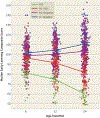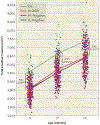Subcortical Brain Development in Autism and Fragile X Syndrome: Evidence for Dynamic, Age- and Disorder-Specific Trajectories in Infancy
- PMID: 35331012
- PMCID: PMC9762548
- DOI: 10.1176/appi.ajp.21090896
Subcortical Brain Development in Autism and Fragile X Syndrome: Evidence for Dynamic, Age- and Disorder-Specific Trajectories in Infancy
Abstract
Objective: Previous research has demonstrated that the amygdala is enlarged in children with autism spectrum disorder (ASD). However, the precise onset of this enlargement during infancy, how it relates to later diagnostic behaviors, whether the timing of enlargement in infancy is specific to the amygdala, and whether it is specific to ASD (or present in other neurodevelopmental disorders, such as fragile X syndrome) are all unknown.
Methods: Longitudinal MRIs were acquired at 6-24 months of age in 29 infants with fragile X syndrome, 58 infants at high likelihood for ASD who were later diagnosed with ASD, 212 high-likelihood infants not diagnosed with ASD, and 109 control infants (1,099 total scans).
Results: Infants who developed ASD had typically sized amygdala volumes at 6 months, but exhibited significantly faster amygdala growth between 6 and 24 months, such that by 12 months the ASD group had significantly larger amygdala volume (Cohen's d=0.56) compared with all other groups. Amygdala growth rate between 6 and 12 months was significantly associated with greater social deficits at 24 months when the infants were diagnosed with ASD. Infants with fragile X syndrome had a persistent and significantly enlarged caudate volume at all ages between 6 and 24 months (d=2.12), compared with all other groups, which was significantly associated with greater repetitive behaviors.
Conclusions: This is the first MRI study comparing fragile X syndrome and ASD in infancy, demonstrating strikingly different patterns of brain and behavior development. Fragile X syndrome-related changes were present from 6 months of age, whereas ASD-related changes unfolded over the first 2 years of life, starting with no detectable group differences at 6 months. Increased amygdala growth rate between 6 and 12 months occurs prior to social deficits and well before diagnosis. This gradual onset of brain and behavior changes in ASD, but not fragile X syndrome, suggests an age- and disorder-specific pattern of cascading brain changes preceding autism diagnosis.
Keywords: Amygdala; Autism Spectrum Disorder; Caudate; Fragile X Syndrome; Neurodevelopmental Disorders; Neuroimaging.
Figures





Comment in
-
Amygdala Involvement in Autism: Early Postnatal Changes, But What Are the Behavioral Consequences?Am J Psychiatry. 2022 Aug;179(8):522-524. doi: 10.1176/appi.ajp.20220509. Am J Psychiatry. 2022. PMID: 35921392 No abstract available.
References
-
- Zwaigenbaum L, Bryson S, Rogers T, et al.: Behavioral manifestations of autism in the first year of life. Int J Dev Neurosci 2005; 23:143–152 - PubMed
Publication types
MeSH terms
Grants and funding
- K12 HD055887/HD/NICHD NIH HHS/United States
- K12 AR084223/AR/NIAMS NIH HHS/United States
- K01 MH122779/MH/NIMH NIH HHS/United States
- P50 HD105354/HD/NICHD NIH HHS/United States
- L40 MH127628/MH/NIMH NIH HHS/United States
- U54 HD079124/HD/NICHD NIH HHS/United States
- T32 HD040127/HD/NICHD NIH HHS/United States
- R01 HD059854/HD/NICHD NIH HHS/United States
- K12 HD001441/HD/NICHD NIH HHS/United States
- R01 HD055741/HD/NICHD NIH HHS/United States
- R01 EB021391/EB/NIBIB NIH HHS/United States
- P50 HD103573/HD/NICHD NIH HHS/United States
- U54 HD086984/HD/NICHD NIH HHS/United States
- R01 MH118362/MH/NIMH NIH HHS/United States
LinkOut - more resources
Full Text Sources
Medical

